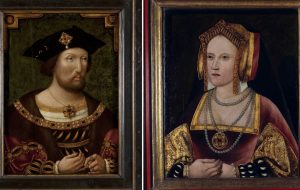
Unknown Artist, ca. 1520. National Portrait Gallery, London UK
My current book project, “Fashioning Catherine of Aragon: Creating the Legend of Henry VIII’s Pious, Loyal Queen, 1501-1630,” is the first book to look at writings by and about Catherine of Aragon from during the early modern period. Although scholarly works have been written about the letters and literary lives of two of Henry VIII’s wives (Anne Boleyn and Catherine Parr), no one has yet undertaken such a study of Catherine of Aragon, despite the fact that she was married to Henry for twenty-five years–longer than he was to all of his other wives added together.
My central argument for this book is that Catherine was by no means the passive, modest, tragic victim epitomized in works like Patrick Williams’s recent biography, Katharine of Aragon: The Tragic Story of Henry VIII’s First, Unfortunate Wife (2014). Instead, I argue that it was Catherine herself who consciously, aggressively, and strategically created her current, and early modern (1450-1750), reputation as Henry VIII’s quiet, modest wife. This perspective illuminates why Thomas Cromwell—the man who engineered the annulment of her marriage from Henry VIII—stated that, “if not for her sex, she would have defied all the heroes of History.” Given that Catherine managed to delay the annulment of her marriage by five years—in major part via her persuasive letter-writing skills and public self-presentations—one can understand why her greatest enemy might praise her in this way. Catherine canny ability to shape her own reputation not only helped her become wildly popular with the English people (despite her birth and upbringing as a foreigner) but was so powerful that it has persisted for five hundred years.
Even as early modern studies—indeed literary studies as a whole—has attended increasingly to epistolary productions by women, Catherine of Aragon’s letters continue to be all-but-ignored. Furthermore, the case of Catherine of Aragon demonstrates how even a Queen Consort who was the daughter of monarchs and wife to a monarch, had no clear legal rights, independent income, or power of her own; she owned only her own persuasive skills. This project, then, is neither biographical nor historical in its primary focus; rather, I focus on the ways in which writers of the period (including Catherine) manipulated rhetoric, visual cues, and emotion to create rival versions of this English queen, versions that would sustain each writer’s desire to impose upon posterity how Catherine—and, by extension Tudor England—should be read and remembered.
By considering Catherine as an agent of her future reputation, I study not only Catherine’s own writings but also the ways in which her persuasive self-presentation inspired a number of sixteenth- and seventeenth-century literary works (such as Shakespeare’s Henry VIII and Calderón de la Barca’s La scisma en inglaterra); historical works (such as Raphael Holinshed’s The Chronicles of England); and posthumous paintings of Catherine of Aragon owned primarily by English Catholics—well after the official conversion of England to Protestantism. I consider, in the process, tracts and treatises written during Catherine’s lifetime that attempted, unsuccessfully, to represent her as an illegitimate, even treasonous wife (such as Cromwell’s 1529 “Remonstrance against the Queen”).